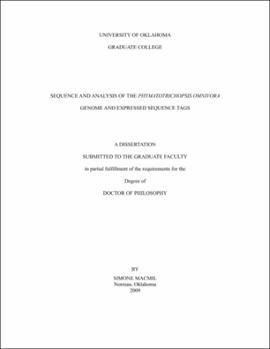| dc.contributor.advisor | Roe, Dr. Bruce A | |
| dc.creator | Macmil, Simone Lynette | |
| dc.date.accessioned | 2019-04-27T21:41:32Z | |
| dc.date.available | 2019-04-27T21:41:32Z | |
| dc.date.issued | 2009 | |
| dc.identifier | 9996832702042 | |
| dc.identifier.uri | https://hdl.handle.net/11244/319361 | |
| dc.description.abstract | Phymatotrichopsis omnivora, a soilborne fungus confined to the southwestern regions of the United States, causes root rot in more than 2,000 species of dicotyledonous plants. To investigate the gene repertoire in this plant pathogenic fungus, a cDNA library containing expressed genes from the three distinct morphological stages in its life cycle and on exposure to three different nutrient conditions and a whole genome shotgun library was sequenced using massive parallel pyrosequencing and analyzed. | |
| dc.description.abstract | Unique expressed sequence tags (ESTs) obtained by sequencing the ends of the cDNA transcripts from each library were examined for homologs in GenBank, KEGG, KOG and COGEME using the Blast alignment program and categorized into groups based on biological function assignment. Normalization and comparison of the metabolic profile of the ESTs from each library revealed stage specific gene expression. | |
| dc.description.abstract | Analysis of the draft genomic sequence indicated that the ~74 Mbp assembly was approximately twice the size estimated by electrophoretic gel karyotyping from P. omnivora protoplasts supporting the hypothesis that this fungus is an obligate heterokaryon with several heterokaryotic nuclei. Approximately 22,000 genes were predicted with 9000 having homologs in GenBank and a further 12,000 sharing domains with proteins in the Pfam database. Annotation of the P. omnivora predicted proteins based on their biological function and metabolic pathways by comparison against the KOG, KEGG and COGEME databases revealed a comparable number of proteins involved in metabolism and cellular processes as found in the well studied filamentous fungi N. crassa and M. grisea. Moreover,P. omnivora was found to encode slightly higher numbers of ABC-type transporters and calcium and heavy metal transporting P-type ATPases than N. crassa and M. grisea. These ATP-dependent proteins likely are involved in the survival of the pathogen in calcareous heavy metal containing soils and on exposure to plant toxins and fungicides. One such protein of particular interest is the homolog of Bcmfs1, a multidrug transporter involved in protection against natural toxins and fungicides. Since P. omnivora also is a filamentous fungus that lacks both functional conidia and an active sexual cycle, this is the first study to provide details of the life style and metabolic profile of fungi with a parasexual cycle. | |
| dc.format.extent | 217 pages | |
| dc.format.medium | application.pdf | |
| dc.language | en_US | |
| dc.relation.requires | Adobe Acrobat Reader | |
| dc.subject | Cotton root rot | |
| dc.subject | Genomes | |
| dc.subject | Nucleotide sequence | |
| dc.title | SEQUENCE AND ANALYSIS OF THE | |
| dc.type | text | |
| dc.type | document | |
| dc.thesis.degree | Ph.D. | |
| ou.group | College of Arts and Sciences::Department of Chemistry and Biochemistry | |
